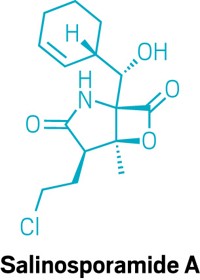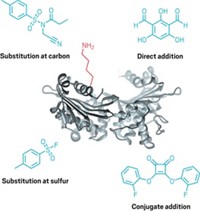Advertisement
Grab your lab coat. Let's get started
Welcome!
Welcome!
Create an account below to get 6 C&EN articles per month, receive newsletters and more - all free.
It seems this is your first time logging in online. Please enter the following information to continue.
As an ACS member you automatically get access to this site. All we need is few more details to create your reading experience.
Not you? Sign in with a different account.
Not you? Sign in with a different account.
ERROR 1
ERROR 1
ERROR 2
ERROR 2
ERROR 2
ERROR 2
ERROR 2
Password and Confirm password must match.
If you have an ACS member number, please enter it here so we can link this account to your membership. (optional)
ERROR 2
ACS values your privacy. By submitting your information, you are gaining access to C&EN and subscribing to our weekly newsletter. We use the information you provide to make your reading experience better, and we will never sell your data to third party members.
Biological Chemistry
Acylfulvene Attack
Researchers learn how potent anticancer agent binds, then breaks, DNA
by Sarah Everts
September 12, 2006
| A version of this story appeared in
Volume 84, Issue 38

Scientists get their first glimpse of how acylfulvenes damage DNA.
Acylfulvenes are a potent class of antitumor agents that were inspired by a toxin in the luminescent jack-o'-lantern mushroom. Although the compounds have been thought to exert their cytotoxicity through DNA alkylation, it hasn't been clear exactly how acylfulvenes might interact with DNA.
The mechanism became clearer with the first structural characterization of acylfulvene-DNA adducts, presented by Shana J. Sturla, a medicinal chemist at the University of Minnesota, before the Division of Chemical Toxicology at the American Chemical Society meeting this week in San Francisco.

Once in the cell, acylfulvenes are bioactivated by an enzyme called AOR, which reduces the carbon-carbon double bond of the compounds'  ,
, -unsaturated ketone. Sturla and colleagues showed that the reactive intermediate created then selectively alkylates purine bases in DNA, such as adenine and guanine, creating a large, bulky adduct.
-unsaturated ketone. Sturla and colleagues showed that the reactive intermediate created then selectively alkylates purine bases in DNA, such as adenine and guanine, creating a large, bulky adduct.
How these adducts contribute to cytotoxicity will be the focus of future work, but there are several possibilities, Sturla said. The unwieldy adducts may block DNA replication and transcription, or they may interfere with other biochemical processes in the nucleus. The adducts are also unstable under physiological conditions and may break off with the purine base attached, leaving a void in the DNA.
"Sturla's work has real-life relevance, as these [acylfulvene] compounds are currently being tested" in Phase II clinical trials, noted Kent S. Gates, a bioorganic chemist at the University of Missouri and cochair of the session in which Sturla presented her work.
Understanding the chemical pathways that acylfulvenes undergo in tumor cells is important for designing better analogs and new strategies that enhance their therapeutic potential, Sturla said.






Join the conversation
Contact the reporter
Submit a Letter to the Editor for publication
Engage with us on Twitter